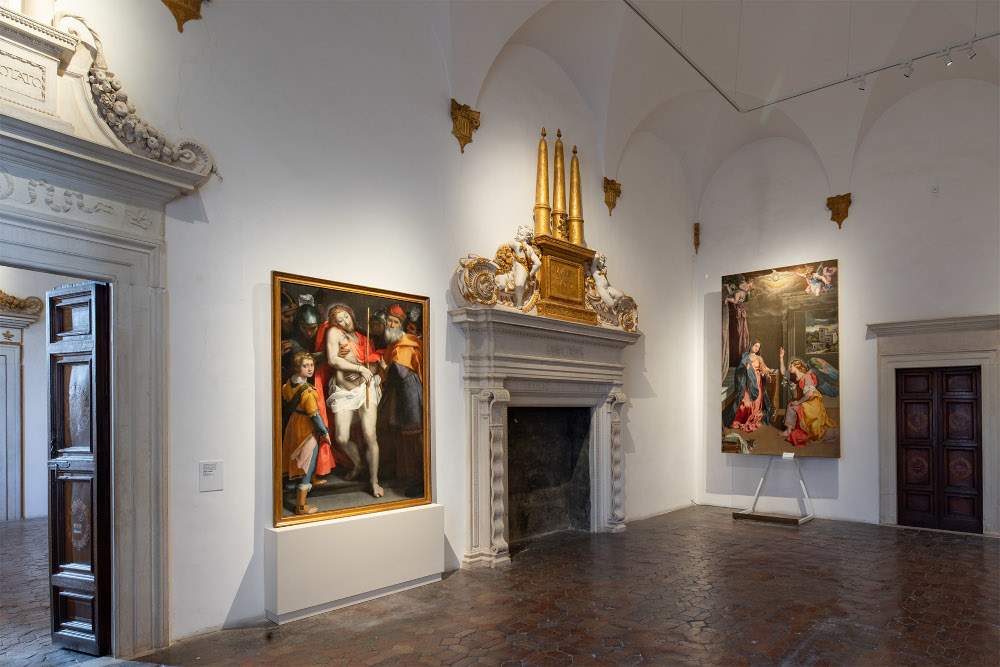On the occasion of the sixth centenary of Federico da Montefeltro’s birth, from April 6, 2022, the Galleria Nazionale delle Marche will expand its museum spaces: in fact, six entirely renovated rooms on the second floor will open to the public, adding to the three on the eastern arm that have already been opened to house some works from the late 16th and 17th centuries, with the important nucleus of paintings by Federico Barocci.
The renovation work involved the entire floor, excluding the part occupied by the offices of the National Gallery Management, including the rooms already open to the public that have been temporarily closed. The goal is the integration of all the rooms on the second floor, through their adaptation to the new lighting design and the new layout, designed and curated by the Gallery’s staff.
There will be a total of several hundred more works that, having come out of storage, it will be possible to admire: 115 paintings and 5 sculptures, about 150 majolica pieces of rare beauty and a selection of ceramics. These will include an important nucleus of works (including paintings and ceramics) from the collections of the Cassa di Risparmio di Pesaro, granted on ten-year deposit to the Galleria Nazionale delle Marche. Added to this will be, from time to time, 24 drawings (many by Barocci and mostly unpublished) that will be shown in rotation for periods of up to four months), in addition to the two large ones that are permanent, namely St. Gennaro being dragged to martyrdom with his companions Festus and Desiderius (the cartoon for the lunette in the chapel of the Treasure of St. Gennaro in Naples Cathedral, a 1633 work by Domenichino done in charcoal, white lead and sanguine on paper) and The Triumph of Silenus (the cartoon for the right-hand side of the central compartment of the vault of the Galleria di Palazzo Farnese in Rome, a circa 1598 work by Annibale Carracci, done in charcoal and white lead on blue-gray paper).
The Galleria Nazionale delle Marche will thus increase the heritage accessible to visitors by 75 percent.
“The Galleria Nazionale delle Marche is a museum that grows and completes its development,” says Gallery Director Luigi Gallo. “Created to represent the art of the Marches, with this and the forthcoming final opening of the second floor, it concludes that path begun at the beginning of the twentieth century, when the Gallery was established. On the one hand, it sees the gradual recovery of all the spaces of the splendid Ducal Palace that houses it, and on the other, the completion of the narrative of the artistic history of a territory so rich and important for Italian culture and not only, extending the exhibition to the collections of the seventeenth and eighteenth centuries, including drawings and, finally, ceramics that of Montefeltro, represented an excellence.”
Theopening of the second floor of the Ducal Palace will take place in two stages: with the April 6 opening, all the rooms previously open to the public are recovered. Of these, only the first three rooms dedicated to Barocci and a small selection of seventeenth-century painters are currently visible. From April 6, moreover, these rooms will also be accessible by an elevator from the Piano Nobile below: the new elevator will be accessed from the gallery formerly dedicated to the Volponi Collection and will lead to the upper loggia overlooking the Pasquino courtyard, now dedicated to the display of ceramics.
The pictorial works will be arranged organically, with a first sector, corresponding to the five rooms already previously open to the public, organized with masterpieces from the late sixteenth and seventeenth centuries: Barocci, Gentileschi, Zuccari, Guerrieri and others.
Visitors will then find themselves in junction rooms (now completely renovated) in which the Wedding Apparatus by Claudio Ridolfi and Girolamo Cialdieri, a series of paintings made in 1621 on the occasion of the wedding of Federico Ubaldo Della Rovere, the last Urbino duke, to Claudia de’ Medici, will be displayed.
Three final rooms follow. The first, intended to house drawings, is renovated and will house, in addition to the two large drawings by Caracci and Domenichino, part of the drawings from the gallery’s collection. This is a nucleus known mainly to scholars and will be revealed to the public for the first time. The other two rooms, dedicated to ceramics, will display the best pieces in the gallery plus a substantial number of majolica pieces in long-term storage related to Feltre production. This nucleus, organized curated by Timothy Wilson and Claudio Paolinelli, constitutes a kind of permanent exhibition.
Some works from private collections will be exhibited to the public for the first time, and it will also be an opportunity to focus on the aspect of ceramic collecting in Italy, especially after the dispersion during the 19th century of many works on the foreign antiques market. The relationship with the territory will also be highlighted, making great masterpieces that have passed through various collections dialogue with some objects from local earthworks and excavations, in order to reaffirm the main role that Urbino had for majolica production in the national and European panorama.
 |
| National Gallery of the Marches: six new rooms on the second floor open April 6 |
Warning: the translation into English of the original Italian article was created using automatic tools. We undertake to review all articles, but we do not guarantee the total absence of inaccuracies in the translation due to the program. You can find the original by clicking on the ITA button. If you find any mistake,please contact us.